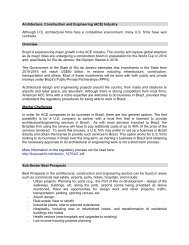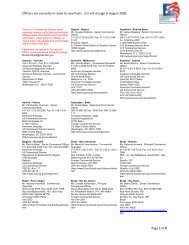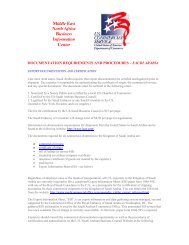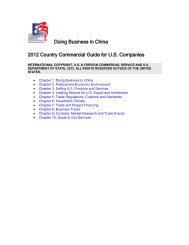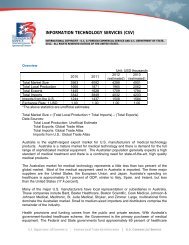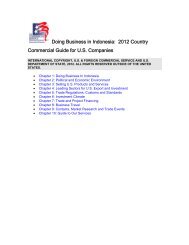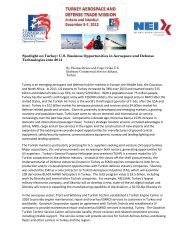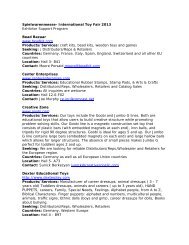Healthcare Technologies Resource Guide - Export.gov
Healthcare Technologies Resource Guide - Export.gov
Healthcare Technologies Resource Guide - Export.gov
You also want an ePaper? Increase the reach of your titles
YUMPU automatically turns print PDFs into web optimized ePapers that Google loves.
European Union<br />
Summary<br />
As the European Union (EU) does not have a Food and Drugs Administration<br />
(FDA), the task of harmonizing requirements and regulating medical devices<br />
is handled by the European Commission in close cooperation with Member<br />
State’s Health Authorities. The purpose of the EU harmonization effort is to<br />
merge the differing national requirements into one law which can be applied<br />
throughout the European Union. Legislation adopted through this process<br />
covers implantable, non-implantable and in vitro diagnostics medical devices in<br />
three separate directives that provide manufacturers the basics to certify their<br />
compliance with EU-wide safety requirements.<br />
Adopted Legislation<br />
The following EU directives are in force throughout the European Union<br />
consisting of 27 Member States (Austria, Belgium, Czech Republic, Cyprus,<br />
Denmark, Estonia, Finland, France, Germany, Greece, Hungary, Ireland, Italy,<br />
Latvia, Lithuania, Luxemburg, Malta, the Netherlands, Poland, Portugal, Slovakia,<br />
Slovenia, Spain, Sweden, Romania, Bulgaria and the United Kingdom):<br />
• Active implantable medical devices (90/385/EEC): Active implantable<br />
medical devices (AIMD), such as heart pacemakers or defibrillators are<br />
defined as “any active medical device which is intended to be totally or<br />
partially introduced, surgically or medically, into the human body or by<br />
medical intervention into a natural orifice, and which is intended to remain<br />
after the procedure.” Considering the potentially high risk factor of such<br />
devices for the patient, manufacturers cannot self-certify and have to rely<br />
on the services of an accredited test laboratory to complete the process of<br />
compliance.<br />
• Medical devices (93/42/EEC): Medical devices are broadly defined as “any<br />
instrument, apparatus, appliance, material or other article, whether used<br />
alone or in combination, including the software necessary for its proper<br />
application intended by the manufacturer to be used for human beings”<br />
for several purposes such as diagnosis, treatment, alleviation of disease<br />
and more. As the range of this directive is broad and leaves room for<br />
interpretation, the Commission has written guidance for manufacturers.<br />
Medical devices include syringes, bandages, wheelchairs, endoscopes,<br />
prescription glasses and contact lens solution among others. As the<br />
range of devices covers minimal risk as well as higher risk devices, the<br />
classification of the product will determine whether a manufacturer can<br />
self-certify or needs to involve the services of an accredited test laboratory.<br />
• In vitro medical devices (98/79/EC): An in vitro diagnostic device (IVD)<br />
is a “reagent, reagent product, calibrator, control material, kit, instrument,<br />
apparatus, equipment or system whether used alone or in combination<br />
intended by the manufacturer to be used in vitro for the examination<br />
of specimens, including blood and tissue donations, derived from the<br />
Statistics<br />
Capital: Brussels, Belgium<br />
Population: 501,259,840<br />
GDP: USD 14.793 trillion<br />
Currency: Euro (€)<br />
U.S. Commercial Service <strong>Healthcare</strong> <strong>Technologies</strong> <strong>Resource</strong> <strong>Guide</strong> | 2012–2013<br />
Contact<br />
Sylvia Mohr<br />
Commercial Specialist<br />
sylvia.mohr@trade.<strong>gov</strong><br />
(32-2) 811-5001<br />
31





